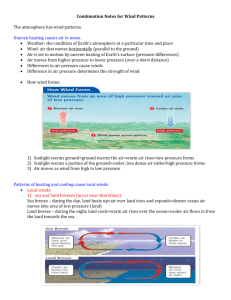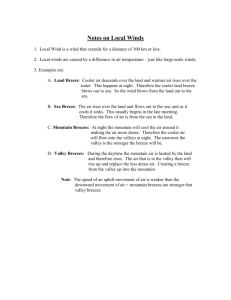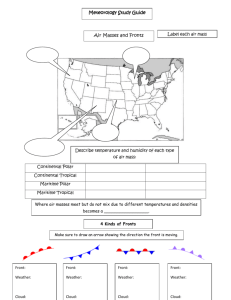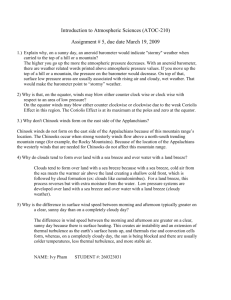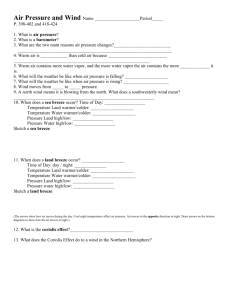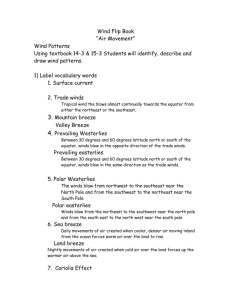Ch 10
advertisement
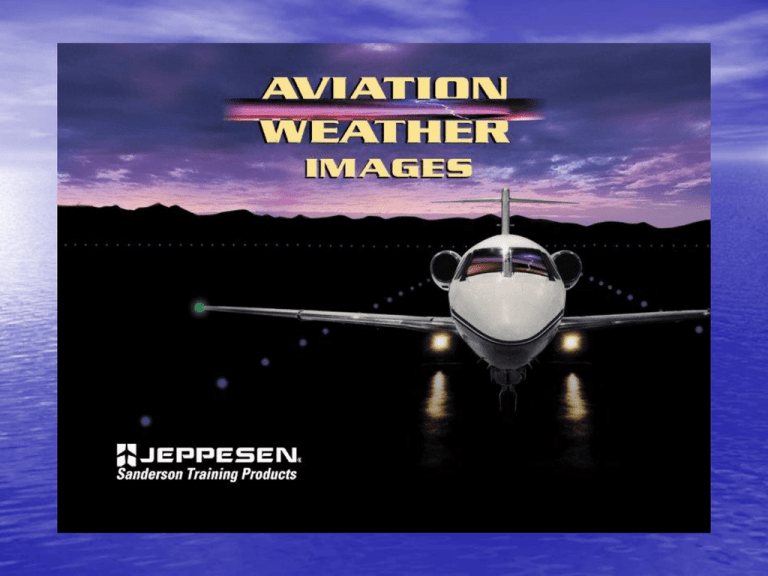
Ch 10 – Local Winds Ch 10 – Local Winds • Introduction – Local winds refer to a variety of mesoscale circulations other than thunderstorms. – These circulations fall into two broad categories. – Thermally driven local winds are caused by local differences in radiational heating or cooling. – They are most noticeable when large-scale wind systems are weak or absent. – Externally driven local winds are produced when strong winds interact with local terrain (Lester, 2006). Ch 10 – Local Winds • Introduction – They are most noticeable when strong, large-scale wind systems are present. – The phenomena discussed under these categories all have the potential to produce important flight hazards. – It is imperative for you to know what their causes and characteristics are, and how to identify them and avoid their worst consequences (Lester, 2006). Ch 10 – Local Winds • Introduction – When you complete this chapter, you will have gained this knowledge and, additionally, you will have condensed it into some useful conceptual models of land, sea, mountain, and valley breezes; mountain waves; and down slope winds (Lester, 2006). Ch 10 – Local Winds • Section A – Thermally Driven Local Winds – Sea Breeze • Sea Breeze Front – Land Breeze – Valley Breeze – Mountain Breeze – Cold Down slope Winds Ch 10 – Local Winds • Section B – Externally Driven Local Winds – Mountain Lee Waves • The Lee Wave System – Warm Down slope Winds – Macroscale Weather Patterns Ch 10 – Local Winds • Local winds – refer to a variety of mesoscale • • circulations other than thunderstorms – These local wind circulations fall into two broad categories: Thermally driven local winds – caused by local differences in radiational heating or cooling – most noticeable when large-scale wind systems are weak or absent Externally driven local winds – produced when strong winds interact with the local terrain – most noticeable when strong large scale wind systems are present Ch 10 – Local Winds • Section A: Thermally Driven Local Winds – Sea breeze – pressure difference so small that you can’t observe it in the isobar patterns on a surface analysis chart • it is large enough to cause cool air to begin moving across the coastline toward land in late morning; this is the sea breeze – Sea breeze circulation – the combined sea breeze and return flow are called the sea breeze circulation – Sea breeze front – the boundary between the cool inflowing marine air and the warmer air over land is narrow and well defined – this feature is known as the sea breeze front Ch 10 – Local Winds • Land Breeze – a few hours after sunset, the land surface near a coast line has cooled much more rapidly than the nearby water surface – when the land becomes colder than the ocean, the pressure gradient across the coast reverses so that the lower pressure is offshore – the low level flow which begins to move from land to sea under the influence of this pressure difference is called the land breeze • Land breeze circulation – the land breeze circulation is also made up of a ground level breeze and an opposite return flow aloft, the reverse of the sea breeze circulation Ch 10 – Local Winds • Upslope wind – the hillside deflects the air producing an anabatic or upslope wind – a return flow is found above the mountain • Valley Breeze – if the mountainside is part of a valley, the upslope flow may be part of a larger scale valley breeze which is also directed toward higher terrain – the daytime valley breeze flows up the centerline of the valley and toward the warm slopes – an opposing return flow is found aloft Ch 10 – Local Winds • Valley breeze circulation - above the mountaintops a weak return flow known as an anti-valley wind is found – the valley breeze in combination with the return flow is called the valley breeze circulation • Downslope winds – the pressure gradient reverses and katabatic or downslope winds develop along the hillsides • Mountain Breeze – on the larger scale of the valley a mountain breeze blows down the valley with a return flow or anti-mountain wind above the mountaintops • Mountain breeze circulation – on the larger scale of the valley a mountain breeze blows down the valley with a return flow or anti-mountain wind above the mountaintops – this configuration is known as the mountain breeze circulation Ch 10 – Local Winds • Drainage winds – cold dense air sinking down the slopes strengthens the down slope and mountain breezes, just as upslope and valley breezes are intensified by warm air rising in convective currents. – Gravity is effective in causing the air to move downward as long as the air near the slopes remains cooler than the air away from the hills at the same level – Small scale flows of this type are called drainage winds • Cold Down slope Winds – cold dense air sinking down the slopes strengthens the down slope and mountain breezes just as upslope and valley breezes are intensified by warm air rising in convective currents Ch 10 – Local Winds • Glacier wind – A shallow layer of cold, dense air flows rapidly down the sloping surface of the glacier. – Gravity accelerates this glacier wind as it moves downslope so the strongest winds occur at the lower end or toe of a glacier. – The maximum speeds depend on the length and steepness of the slope of the glacier and the free-air temperature. – Extreme examples of such winds are found along the coast of Antarctica. • Bora – An example of an extreme cold downslope wind is the Bora. – It develops along the coast of the former Yugoslavia in the winter. – The terrain slopes steeply from the Adriatic Sea to about 2,000 feet AGL. – Gravity accelerates shallow, cold airmasses moving from the east, down the steep mountain slopes to the sea. – In extreme cases the cold air reaches the coast with speeds in excess of 85 knots. Ch 10 – Local Winds • Section B: Externally Driven Local Winds • Mountain Lee Waves – when a stable airstream flows over a ridgeline, it is displaced vertically. – Downwind of the ridge, the displaced air parcels accelerate back to their original (equilibrium) level because the air is stable. – They arrive at the equilibrium level with some vertical motion and overshoot it. – They again accelerate back to the equilibrium level and over shoot only to repeat the wave-like oscillation as they are swept downstream with the horizontal winds. – The mesoscale wave pattern that they follow is known as a mountain wave or mountain lee wave. – It is a particular form of an atmospheric gravity wave. Ch 10 – Local Winds • Atmospheric gravity wave – in a stable atmosphere • gravity through stability plays a major role in forcing the parcels to return to and oscillate about their equilibrium level Lee wave system – all lee waves regardless of their geographic location produce certain common flow features and clouds. – These characteristics are captured in the idealized model of the lee wave system; figure 10-12. – In the lee wave system, airflow through the lee waves is indicated by thin solid lines with arrows. – The mountain (green) is located on the left side of the diagram. – The lower turbulent zone is shaded and characteristic lee wave clouds are shown in white. Ch 10 – Local Winds • Lee wave region – the lee wave system is divided into • • two layers, an upper lee wave region where smooth wave flow dominates and microscale turbulence occasionally occurs and a lower turbulent zone Lower turbulent zone – this is from the ground to just above mountain top level where turbulence is common Primary cycle – in the lee wave portion of figure 10-12 the most intense lee wave is the first or primary cycle immediately downwind of the mountain. – Successive cycles tend to have reduced amplitudes. – Lee waves have their greatest amplitudes within a few thousand feet above the mountains, decreasing above and below. Ch 10 – Local Winds • ****THE CONDITIONS MOST FAVORABLE TO WAVE • FORMATION OVER MOUNTAINOUS AREAS ARE A LAYER OF STABLE AIR AT MOUNTAIN-TOP ALTITUDE AND A WIND OF AT LEAST 20 KNOTS BLOWING ACROSS THE RIDGE**** ****CRESTS OF STANDING MOUNTAIN WAVES MAY BE MARKED BY STATIONARY, LENS-SHAPED CLOUDS KNOWN AS STANDING LENTICULAR CLOUDS**** Ch 10 – Local Winds • Cap cloud – clouds immediately over the mountaintops • Roll cloud – the cumuliform rotor or roll cloud associated with the rotor cumuliform and the smooth lens shaped altocumulus standing lenticular (ACSL) or lenticular clouds in the crests of the lee waves. – Higher lenticular clouds are sometimes reported as CCSL in aviation weather reports. • Altocumulus standing lenticular (ACSL) / lenticular clouds - the crests of the lee waves – higher lenticular clouds are sometimes reported as CCSL in aviation weather reports. Ch 10 – Local Winds • Chinook – a Chinook or foehn is defined as a warm dry • gusty wind that blows from the mountains Warm downslope winds – identified by many different local names. – Although the terms Chinook and foehn are used widely now to describe downslope winds in many geographical areas, they also come from specific regions. Summary • Chapter 10 has shown how the simple concept of • • thermal circulation is used to explain the development and general features of sea and land breezes, mountain and valley breezes, and drainage winds. Such small-scale circulations can certainly affect flight conditions, but their presence is not immediately obvious on surface analysis charts. The information you have learned in this chapter will help you anticipate winds produced by local terrain and land-water differences (Lester, 2006). Summary • Additionally, when large-scale circulation systems such • as extra tropical cyclones make their way across rugged terrain, interactions of their winds with mountains and hills produce other unique mesoscale circulations including mountain lee waves and warm down slope winds. These phenomena offer many more serious problems to pilots than do most thermally driven circulations (Lester, 2006). Summary • An added difficulty arises because the conventional • network of surface weather observing stations does not observe these mesoscale circulations very well. Therefore, there is not much detailed information available to the pilot to determine, for example, the location and strength of lee waves for flight planning and avoidance purposes (Lester, 2006). Summary • Your new knowledge of the model of the lee wave system and of large-scale patterns favorable for lee wave development will prove exceptionally valuable in your analysis of the presence and intensity of lee waves (Lester, 2006).

